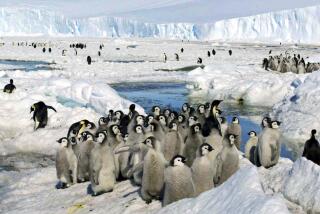Navy Puts the Antarctic on Ice
- Share via
PORT HUENEME — It was 42 years ago that the Navy began cutting the first path and building the first shelter at the last place on Earth, breaking the ice for American researchers studying some of the most compelling scientific questions in Antarctica.
Since the mid-1950s, scientists have learned much on the highest, driest, coldest and windiest continent on Earth, determining the likely cause of the antarctic ozone hole, discovering a meteorite that suggested life on Mars, filming the crash of a massive comet into Jupiter.
On Thursday, during a ceremony at the Port Hueneme Navy base that “Operation Deep Freeze” has called home since 1975, the Navy marked the end of an era, formally disestablishing the U.S. Naval Support Force, Antarctica.
“It’s a sad day for the Navy,” said Capt. C.H. “Hugh” Smith, Deep Freeze’s last commander. “It’s not something we want to celebrate, but it’s one whose time has come.”
Following a cost-saving decision driven by military downsizing at the end of the Cold War, the Navy is turning over its logistical support for American scientists in Antarctica--chiefly transportation to research sites--to the Air Force and New York Air National Guard, which both have served explorations of the North Pole for years.
The Navy’s VXE-6 squadron based at Ventura County’s Point Mugu will continue to provide limited air support for researchers for one more year.
The austere beauty of Antarctica has lured Navy types back for tour after tour since logistical support for the nation’s scientists began in late 1955.
“By far, it is the most interesting, rewarding and memorable thing I have ever done in my entire life,” said Charlie Bevilacqua, 67, who arrived with the Navy’s first construction crew in Antarctica. “Until they put me in a rocket and send me to the moon, nothing will compare to Antarctica.”
*
However, the Antarctica of today is a far different place than those first Navy pioneers encountered at the bottom of the Earth.
Today, several nations run scientific research stations there. The United States’ McMurdo Station, the largest base on The Ice, serves as home to 1,200 military personnel and scientists each summer. McMurdo has power lines, water pipes, telephones, stores, clubs and bars.
“What the Navy has done is made the U.S. program the envy of all the other countries that are involved in polar science,” said Erick Chiang, head of the National Science Foundation’s polar research office.
But in the eyes of the Department of Defense, Smith said, the roughly 780 Navy personnel who once supported National Science Foundation efforts each year are the equivalent of a crew to staff an Aegis cruiser.
With the Pentagon drawing down the size of the service, officials decided to dedicate the Navy’s remaining forces to its war-fighting mission.
Operation Deep Freeze “wasn’t war fighting,” Smith said. “It was in support of science. It was a good thing, but . . . if it’s not war fighting, we’re not going to be doing it.”
*
Thursday’s ceremony drew scores of military veterans and civilians who spent time on The Ice--from Bevilacqua who in 1956 became one of the first humans ever to step foot on the geologic South Pole to Master at Arms Chief Petty Officer Pat Woodard, the last member of Operation Deep Freeze to step off.
The Navy’s presence in Antarctica dates to Operation High Jump in 1946, the most aggressive expedition to Antarctica ever attempted.
With 13 ships and 245 aircraft, the Navy tested and trained 4,700 Navy personnel in a harsh environment while establishing American presence on the continent.
The Navy used an aircraft carrier, two ice breakers, three ships and a submarine to penetrate the pack ice and establish a base in the Bay of Whales in the Ross Sea.
Meanwhile, two sets of seaplane ships, tankers and destroyers headed in opposite directions to survey the continent, with seaplanes flying when weather permitted.
Operation High Jump marked the first time helicopters and ice breakers were used successfully in Antarctica.
The expedition also began the legacy of the Navy Seabees on the continent. In 1956, Seabees began constructing the first buildings, airfields and harbors on Antarctica, including the first Navy base on the Ross Ice Shelf.
*
Bevilacqua was a young Seabee who specialized in cement and carpentry work. He remembers those first days, when the Navy construction crews slept in tents and empty wooden crates that had carried electrical generators.
He remembers the day when a tractor driven by his friend, Richard T. Williams, fell through thinning bay ice, marking the first of 50 deaths associated with Deep Freeze operations.
And he vividly recalls parachuting from a plane with a team of 18 other Seabees in an effort to pinpoint the geologic South Pole--and establish a camp there.
“When we got to the South Pole, there was absolutely nothing there,” Bevilacqua said. “We didn’t even know where the South Pole was.”
But even before the High Jump and Deep Freeze operations began, it was Rear Adm. Richard E. Byrd who set the stage for the United States presence in Antarctica.
During a privately funded expedition in 1928, Byrd established a tiny base on the Ross Ice Shelf called “Little America,” from which he and three companions departed for the first-ever flight to the South Pole on Nov. 29, 1929.
On a second expedition in 1934, Byrd spent five months alone in the perpetual darkness of an antarctic winter. He later took an active role in both Operation High Jump and Operation Deep Freeze.
“I think he’d be sad,” said Byrd’s grandson, Robert Byrd Breyer of Los Angeles, who attended the ceremony with his mother--Byrd’s daughter--Katharine Breyer.
*
“He was always a realist,” Robert Breyer said of his grandfather. “He’d understand.”
That is the way most seemed to take the Navy’s departure on Thursday.
For Billy-Ace Baker of Pensacola, Fla., who years ago legally changed his middle name to “Penguin,” the disestablishment ceremony resembled more of a wake.
“It’s a funeral,” said Baker, 61, who “wintered over” four times in his Navy career from 1962 to 1980. “Somebody died. A real old friend has died.”
But Master at Arms Chief Woodard said he is happy just to have had the chance to see and experience Antarctica.
“To observe it, to see it, to work in that environment was hard at times, but it was rewarding as well,” Woodard said. “I really hate to see us go.”
Capt. Smith said he too will never forget the experience.
“It’s just the majesty of it all,” he said. “Being down there, you experience the weather and the hardship, and it’s hard to describe the vastness of the place. When you get into the open plateau, you can see forever. . . . And there was always a sense that you were doing it for a good cause.”





